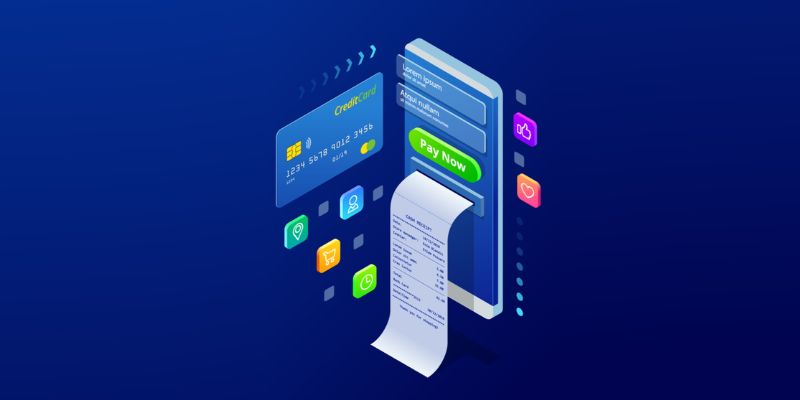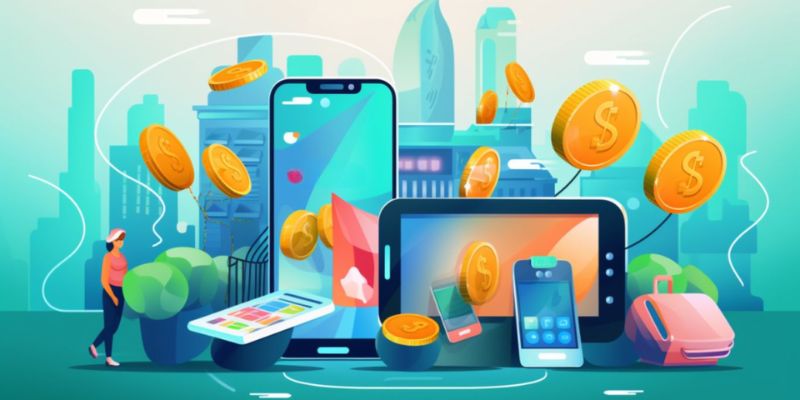The digital landscape is shifting, and with it, the Digital payment platforms trends are reshaping how we think about transactions. As your guide through the maze of cashless dealings, I’ve seen the waves that are morphing tomorrow’s payment protocols. We’re not just moving toward a world where cash is a memory; we’re sprinting there. Ready to dive into the current surge of cashless transactions and the tech that’s powering them? Stick with me, and let’s explore the touchpoints shaping this digital revolution—from tap-and-go payments to the biometric tech guarding your digital wallet.
The Rise of Cashless Transactions: A Global Movement
The Drive Toward Contactless Payments Growth
People love fast and easy ways to pay. Contactless payments are just that. Tap a card, a phone, or even a watch, and done! Payment made. So quick! This magic is thanks to a tech called NFC, or Near Field Communication. Shops, buses, and even vending machines use NFC. It lets you pay without touching anything. That’s why during health scares, folks choose it more.
But it’s not just about health. Safety is key too. Your card’s info, like the number, stays safe. It’s because each tap sends a unique code. It’s not the real card number. Smart, right? And you can set a limit on how much to spend. This way, thieves can’t take a lot if they get your card. Plus, contactless payments are now going globetrotting – work anywhere! Like when you grab coffee in Paris or buy a souvenir in Tokyo, easy peasy.
Analyzing the Impact of a Cashless Society
No more cash sounds like a big deal, right? But it’s happening. Day by day, cashless is the way. What’s cool is it’s not just in big cities. Even small shops are going cashless. It’s because folks now have smartphones everywhere. And with apps, they have a bank in their pocket.
Kids even see how easy it is. They use apps to split snack money with friends. This is called peer-to-peer payments. Safe and simple. But hey, it’s not just about buying stuff. It’s also about helping everyone join in. Like people who live far from banks. With a phone, they can send money back home.
Yet, some folks worry. What about folks who are not good with tech? Or those who just like cash? That’s something shops and banks are thinking hard about. They want everyone to feel okay with no cash around. It’s a big change, and even laws are trying to catch up. They want to keep your money safe online.
Cashless also means getting paid in a flash. Real-time payments are growing fast! Got paid today? The money’s ready to use right now. And less waiting for stuff you buy online to get shipped. E-commerce is on fire with fast pay.
All in all, cashless is not just here to stay; it’s set to rule the day. It’s easy, safe, and good for everyone. So, next time you see someone tap to pay, know it’s part of a big change. And we’re all part of it. Let’s see where this cashless thing takes us!

Mobile Wallets: More Than a Trend
Strategies for Mobile Wallet Adoption
First, let’s tackle a big question: How do we get more people to use mobile wallets? Simple: make it easy, safe, and worthwhile. Here’s how. Offer rewards for using mobile wallets. People love getting something extra. Show them how quick the checkout can be. Time is precious to everyone.
Next up, teach them. Mobile wallet adoption grows when folks understand it. No one uses what they can’t figure out. Businesses need to explain the steps. And don’t forget about trust. People need to feel their money is safe. Use tech that protects them, like biometric authentication methods.
Now, let’s add family and friends to that list. Peer-to-peer payment systems are key. They let people send money like a text. Easy, right? That’s because it’s natural to trust a system if loved ones do. So if my friend pays me for lunch with a mobile wallet, I’m sold.
Safety is the final piece. Enhance payment security and folks will listen. No one wants their cash lost to fraud. Talk about regulation of digital payments. It’s the gate that keeps the bad guys out. And if someone says, “Mobile wallets? That’s risky!” Tell them about tokenization in payments. It’s tech that keeps card details secret.
The Emergence of NFC Payments and QR Codes
Now onto some tech magic – NFC payments and QR codes. Here’s the cool part: NFC payments let you pay by waving your phone near a reader. It feels like a magic wand. This tech is growing fast. Know why? It’s because folks love to tap and go. Soon, digging for cash will seem old-fashioned.
And QR codes? They’re like a secret language between your phone and the register. Just scan and pay. QR code payment adoption catches on because it’s super simple. Got a camera on your phone? Then you’re set. It doesn’t ask for much. Even my grandma is in on the trend.
Real-time payments increase because of tech like this. You buy your coffee, and bam – paid! It’s not like the old days of waiting. It happens in the blink of an eye. This ease makes digital wallets more popular every day. Watch out, old wallet, your days are numbered.
Finally, remember, a cashless society has a huge impact. It changes everything – how we shop and how businesses work. It’s not just about paying with a phone. It’s about moving to a world where paying is a breeze. You know, the kind where you forget you’re even doing it.
So let’s wrap this up. Mobile wallets are a thing now, and they’re here to stay. We’ve just got to spread the word, lock it down with security, and keep making it cooler. It’s more than a trend. It’s the future knocking on your door – and it’s asking, “Can you tap to let me in?”

Biometric Authentication: Securing Digital Payments
Innovations in Biometric Authentication Methods
Let’s dive into biometric authentication. Think of it as your body’s secret handshake with technology. It’s getting big, especially in phones and laptops.
What is biometric authentication? It’s tech that knows you by your body parts like your fingerprints, face, or voice. Instead of a password, your phone checks if it’s really you. Think of it like a smart guard that never forgets a face.
Companies are getting smart with this stuff. They’re using fingerprints and faces to keep your money safe. No more tricky passwords. Just you, being you. And it’s fast! Payments happen in a snap.
But wait, there’s more. Eye scans and heartbeats may be the next big thing. Imagine paying with a wink or the unique beat of your heart! Sounds like sci-fi, but it’s real, and it’s happening.
The Role of Biometrics in Combating Fraud
Forgery and stolen passwords are old news. But with biometrics, these cons are hitting a wall. If a crook doesn’t have YOUR eyes or YOUR thumb, they’re out of luck. It’s like having a superpower against theft.
So, how does this stop fraud? Well, no two people are just alike, right? That makes your biometrics your own personal shield. Crooks can’t fake them. That’s a game-changer!
But let’s be real. No tech is perfect. Sometimes biometrics mess up. It might not know you with a new haircut. Or when you’re all puffy from a bee sting. Weird but true.
That’s why it’s smart to have a backup. Maybe a code or a card. But even with those rare mix-ups, biometrics are pretty solid in keeping your cash safe.
In simple words, biometrics mean less worry for you and tougher times for the bad guys. And that’s a win in anyone’s book!

Blockchain and Cryptocurrencies: A New Era of Payment Solutions
Blockchain’s Influence on Payment Security and Transparency
Blockchain is changing how we keep money safe and clear. It stores data in chunks called blocks. These blocks link up in a chain. It’s tough for hackers to mess with. Each block has a unique code. When a block changes, the code changes. So, if a hacker alters a block, the next block’s code won’t match. Everyone on the network sees this. You can’t change past data without a nod from everyone. This keeps our money secure.
Not just safety, blockchain’s clear too. Every transaction is there for people to see. But here’s the trick – personal info isn’t shown. Instead, you get a complex code that stands for your transaction. This means we can track money without giving away who we are. Quite cool, huh?
The Integration of Cryptocurrency Transactions into Mainstream Finance
Cryptocurrency. It’s digital money. Think Bitcoin or Ether. No paper, no coins, just numbers online. People buy stuff with it, and even save it, like gold. It’s not just for tech experts or rich folks. Businesses let you pay with it now. In some places, you can buy a sandwich with a digital coin. Even big companies are joining in, letting you check out with crypto.
Why do people like it? It’s quick, it goes across borders, and you don’t always need a bank. It’s a peer-to-peer thing. You send money straight to someone, anywhere in the world. No waiting for banks. Plus, it has this thing called a blockchain backing it. So, it’s not just fast; it’s safe too.
Folks also dig it for another reason – it keeps our money private. We get to hold onto our financial privacy. That’s a big deal for many.
But, not everyone’s on board yet. There’s talking about rules for digital money. Countries want to make sure it’s safe and fair. So they’re working out how to watch over it. This could be a good thing. It helps folks trust using digital coins. Even with rules, we can still enjoy the freedom crypto gives.
Real-time payments are rising. We send and receive money right away. No more waiting days for a check to clear. People love it because it’s easy. They get to use their money fast.
Mobile wallets are getting huge. They’re apps that hold your money, so you pay with your phone. Forgot your wallet? No problem, just tap your phone and you’re good to go.
Here’s another big thing – biometric security. We’re talking fingerprints, faces, even voice checks. This tech checks who you are. So only you can get into your digital wallet. It stops thieves cold.
Digital payments are not a fad. They’re our future. And I can’t wait to see where we go next. Keep your eyes peeled for the next wave, like wearable gadgets that pay for stuff. Or smartwatches doubling as wallets. This world of quick, easy, and safe money is getting bigger every day.
In this post, we’ve explored how paying without cash is becoming huge worldwide. We saw how tap-to-pay is on the rise and how much a cash-free world can change things.
We also dove into mobile wallets. They’re more than just a fad. People are getting on board and tech like NFC and QR codes are making it easy.
Then, we looked at biometric checks. These are new ways to keep digital payments safe. They help fight stealing and fraud every day.
Lastly, we talked about blockchain and cryptocurrencies. They’re shaking things up in how we think about money, making payments safe, and open for all to see.
To wrap it up, the way we pay is changing fast. We’re moving to systems that are quick, safe, and easy for everyone. It’s an exciting time with lots of new stuff to learn and use. Let’s keep our eyes open for what comes next in the world of payments!
Q&A :
What are the emerging trends in digital payment platforms?
The digital payment landscape is constantly evolving with new technologies and consumer behavior patterns. Some of the emerging trends include the rise of mobile payments, increased use of contactless transactions post-pandemic, the integration of Artificial Intelligence (AI) for enhanced security and personalized experiences, the adoption of blockchain for reduced fees and more transparency, and the growth of Buy Now, Pay Later (BNPL) services. Businesses and consumers alike are also showing more interest in digital currencies and mobile wallets.
How are mobile wallets impacting digital payment trends?
Mobile wallets are becoming increasingly popular as a convenient and secure method for digital payments. They impact digital payment trends by encouraging cashless transactions and enabling users to streamline their payment processes. Mobile wallets support not just in-store payments, but also online shopping and peer-to-peer transfers. The ease of use, added security features such as biometric verification, and loyalty and rewards programs integrated within mobile wallets are key factors driving their adoption.
What role does cybersecurity play in digital payment platforms?
Cybersecurity is critical in digital payment platforms as it builds trust and ensures the protection of sensitive financial data. The role of cybersecurity is to safeguard against fraud, data breaches, and other cyber risks that could compromise the integrity of digital payment systems. Implementing robust encryption, multi-factor authentication, and continuous security monitoring are some measures that platforms are taking to enhance security. As digital payment platforms continue to grow, investing in advanced cybersecurity measures is becoming more essential to protect users and maintain regulatory compliance.
Are cryptocurrencies becoming mainstream in digital payment platforms?
Cryptocurrencies are gradually becoming more mainstream as digital payment platforms explore the use of blockchain technology. They offer advantages such as lower transaction fees, decentralization, and potentially quicker cross-border transactions. However, widespread adoption is hampered by factors such as volatility, regulatory uncertainty, and lack of understanding among the general public. Despite these challenges, some platforms and merchants have started to accept cryptocurrencies, indicating a trend towards more widespread use in the future.
What is the future of digital payment platforms?
The future of digital payment platforms is likely to be shaped by continued innovation in FinTech, further adoption of cashless solutions, and the integration of new technologies. We can expect to see a greater emphasis on user experience, with seamless and frictionless payments across various channels. The development of central bank digital currencies (CBDCs) could also play a significant role, as well as the potential mainstream adoption of cryptocurrencies. Interoperability between different payment systems and the harmonization of global payment regulations could additionally influence the trajectory of digital payment platforms.

